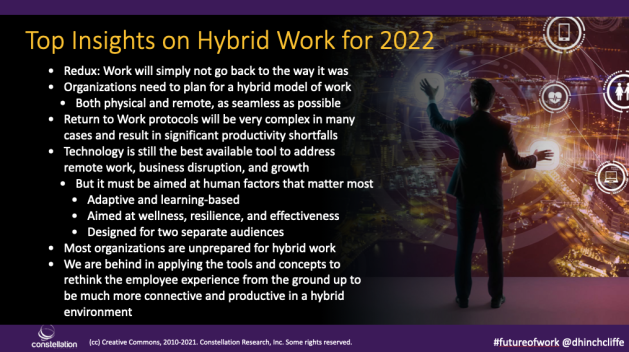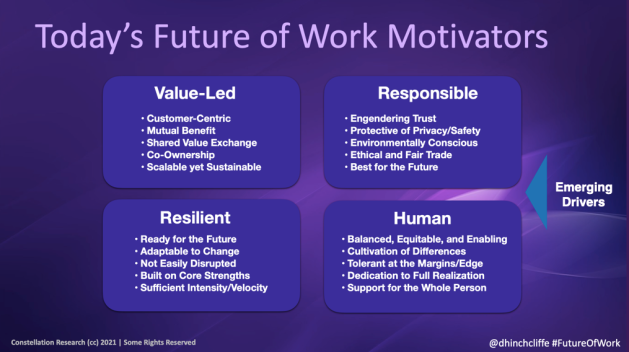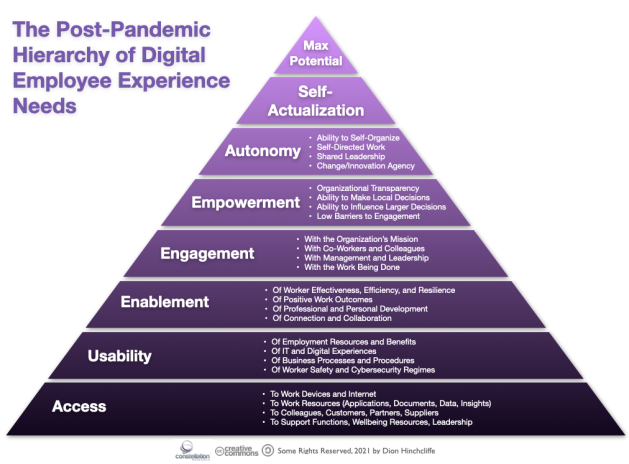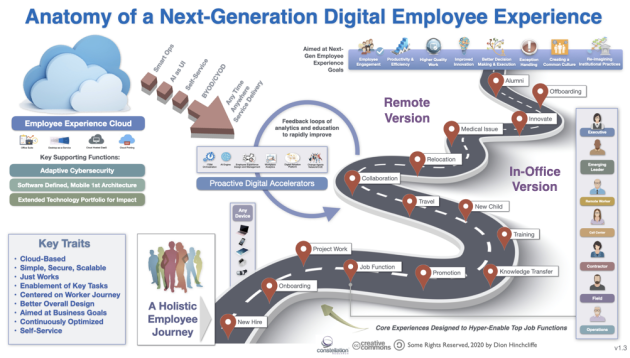How to Think About and Prepare for Hybrid Work
October 12, 2021 1 Comment
Over the last year-and-a-half there have been two priorities for digital transformation, with two different transformations that have happened in our organizations. The first was customer experience, and has largely proceeded well, with a few challenges. The other major change was in the workplace itself. Tellingly, the transformation of work has been, frankly, the harder challenge, and always has been.
First, the good news: I have been largely gratified to see that budgets and priorities for digital workplace and digital employee experience are higher than ever before. The reason is simple: The urgency is there like never before. But we’re still having significant challenges getting our organizations focused on meeting worker needs in this regard during the pandemic, even determining what those needs really are. Some parts of the near future are clearer however: By all indications, work is not going to go back to the way that it was.

Instead, the hybrid model is now generally agreed upon by most as the future of work, both physical and remote, but with a need for it to be as seamless as possible across both groups of workers. And ultimately, it’s the seamless part that will be the challenge, the hardest part to get right, and probably the most important part to address.
A return to the office is going to happen at scale soon, and is even now happening in many places in the United States and in the world. But for most, it will be next year, 2022, as the global return to the workplace for most of us. As it was during the pandemic, technology is still the best tool we have to address our problems, challenges, and opportunities with disruptive shifts to the the work environment. But the tech has to address human needs, first and foremost. So one of the big messages here is that success will require aiming at and achieving worker-centricity like never before.
Simply put, if organizations wish to attract and retain workers in these very trying times, where labor markets are so very tight, we have to design it around those same people. So as to be very adaptive to them, and to educate them, and to be focused on their wellness. There have been bold experiments in some of the efforts i’ve advised, where they actually monitor the mental and physical wellbeing of the workers in real time and provide assistance to them if they need it. While these tend to be large organizations that to do this, helping workers to be resilient and helping them to be effective during confusing and challenging moments will be vital. These digital employee experiences will be designed more deliberately not for one audience, not just for the office, and not just for remote work.
Last year I was on record saying that we should focus on designing for remote work-first, otherwise we’re going to underdeliver for the remote worker, the largest group in most organizations. But this year and going forward, we have really have to put in-office and remote workers on the same footing. I also see that most organizations are still unprepared for this. They want to do deliver on it, but they’re unprepared and they’re behind in applying the tools and concepts available to them. I’m hoping what we have now learned will help them get ahead.
Getting the Foundation and Values Right for Hybrid Work
And so in the visual below are the four major focus areas we must deliver on if we wish to be an enlightened organization that seeks to understand what they should best be providing in terms of their workplace and services with their workers in general. Hybrid workplaces — like all workplaces — need to be value-led, and that’s around mutual benefit as much as possible, with shared value exchange and co-ownership. This is already exhibited in many of the things that we see in the most modern collaboration tools: We are co-workers whenever we work together, we share together, we co-create together in a scalable but sustainable way. And it has to be responsible in our world as well, and in terms of creating trust, protecting workers, and their privacy and safety. To be environmentally conscious, ethical and fair trade. All those important aspects that we really value in ourselves and in our organizations. All of this has to be embodied deeply in the hybrid employee experiences that we create in order for them to be properly realized.

We must also be resilient now more than ever before, so ready for that future that is coming faster at us, more chaotically. Workers must be provided with a work environment that is very adaptable to the two main settings of hybrid work. These environments must inherently be harder to disrupt, since it’s increasingly clear that we live in a world that’s more easily disrupted now, and more frequently disrupted as well. And above all hybrid work must address what it means to be human, meaning it is fair and equitable, and genuinely cultivating our differences, because we are all different in our own way.
We must also be prepared to support the edge of our networks and organizations, for experiments and the eccentric but often useful new behaviors and ideas. I’ve spoken many times in the past about the companies that have lived the longest. They have tended to be very humane organizations that are very tolerant on the edge of eccentricities and innovation. As a result and due to fostering this, and providing support for the whole person, not just the worker part of the person, they have lasted the ag, through all disruptions so far.
Collectively then, this is the future of work, the motivations and aspirations that matter the most, as I see it, for enlightened organizations, which most of us aspire to become.
The Biggest Concern About Hybrid Work: The Divide
So if we look at what top leaders are seeking in hybrid work — I’ve spoken with dozens of CIOs since all this started and many CHROs as well — and if you look at their top goals, there’s a real concern about connecting office workers with remote workers. Connecting them together equitably is widely believed to be a very hard yet important challenge. Some organizations are in fact just saying, “we just can’t do it. We’re going to favor the office workers.” A lot are tacitly doing exactly that. And that will really be leaving behind some of their most valuable and most dynamic workers. But many would still prefer not to.
So there is real interest in maximizing the inclusion between office and remote workers. There are genuine challenges in achieving this: What do you do about key worker groups like agile teams, for example? Agile teams are supposed to be co-located so that information flows very quickly among them. I’ve had CIOs ask me how do we deliver agility during hybrid work? Do we keep Zoom calls open between the office workers and remote workers, all day long? While that’s probably not the answer, it’s an example of a central class of problems in digital employee experience that organizations seek answers to:
How do we properly rethink vital business processes that will be divided between two distributed groups of workers?
In general, what organizations actually want to know is what they should do that works? In other words, what are the overall best practices of hybrid work? However, I am sad to report that there mostly is no set of existing best practices yet. Fortunately, over the next year we’ll see the greatest number of experiments in hybrid work that we’ve ever had before. In the process, we are going to find the way, as we collectively learn from what’s really working out there. As part of this, I will gathering success stories, patterns that work, and I will continue to share them.
What’s the Immediate Goal of Hybrid Work?
Leaders also want to preserve the productivity dividend of remote work. Productivity is up in most organizations right now, when we are mostly remote. But now with hybrid, we want to preserve and continue this. And we want to sustain the engagement long term of remote workers themselves as employees. Most organizations I speak with are acutely aware that they have 18 months worth of new hires that many of them have never met. They’re not really connected to the mothership like the workers before. So how do we how do we do that, how do we address engaging effectively with remote workers?. And then how do we deal with all the disruptions that are yet to come? These are the three leading priorities in achieving a hybrid work model. We care about all the other motivators above too, but these stand out.
In fact, if organizations do nothing but address these three goals, they’ll be doing well next year.
The journey itself to hybrid work is now over halfway done. There are three phases that lead there: The pre-pandemic way of working, or the way life that was before, where in-office was dominant and a some of us had VPNs and we could work remotely. And while some did work remotely, but it wasn’t a very large audience. And now that has flipped. We’re still in that flip, with more remote workers than in-office. But people are streaming back now because people are starting to go back to the office. Next year we’re going to end up with that mix, that will average in the 60/40 range, though your mileage will certainly vary.
Key Organization Roles over Hybrid Work
Last year I began to receive calls for the first time from Chief Operating Officers (COOs.) I had never received a call from a COO before. The CIO is the leader that traditionally rolls out new technology solutions and the COO has to operate the company wit the tech the former provides. When they called me, they were saying “I need to be able to run the company with everyone remote. I don’t know what to ask the CIO and CHRO for in order to do this. So how do we do this? I don’t know how to run a company through a WiFi connection. Can you tell me what I should be asking for?”

The Three Phases of Work: Pre-Pandemic, Remote Work, Hybrid Work
And so know this of those in the COO role, they’re very operationally focused, and trying to get their organization through the turmoil of going remote, and now hybrid. Consequently, if you’re trying to drive change, the COO is a role you should be tapping into if you’re seeking to make realize hybrid work today. They’re in the middle of it, they want to do it now (and not in some theoretical future) and they’re willing to try anything to see if it works. So it’s a very exciting new role that we’ve learned that has been involved in trying to make all of these changes during the pandemic both effective and functional.
What Do Workers Need During Hybrid Work
The upshot is that we’re now at this moment in the rebirth of work. That the future is not the model of remote work that we’ve had over the last year and a half. Now is the time when have to start really becoming effective at hybrid work. And that means connecting two very different audiences and that’s really the challenge. To do this, we’ll need a target model for digital employee experience and the resulting engagement that we should be aiming for and can use as a cross-check. Something that we can use to layer our design into and ensure we are creating the right result. As a primary check, I have developed a model for digital employee engagement that is based on Maslow’s hierarchy that has been very well received.

For post-pandemic, this hierarchy is a view of our employee experience needs. If you look at the bottom of it, there are the fundamentals, which is mostly basic access: Getting people access to their devices and the Internet, to their documents, applications, and data, in touch with their colleagues, customers, partners and suppliers, and all the support functions that make them work. This basic access means being able to reach them.
Then the next step up is once you’ve provide access, it is to make the digital employee experience usable. And really because access actually doesn’t really provide that much value without usability, it has to be something you can actually deliver on. And so usability also covers having streamlined digital experiences, making business processes and procedures easily learned and usable, making sure your cybersecurity protections aren’t making the access too difficult. In fact, we still see cybersecurity practices are creating a lot of challenges for usability. Your overall digital workplace can suffer greatly if you don’t solve for easily usable security procedures and experiences.
An organization might have the best digital workplace capabilities in the world with a a wonderful design, but if workers are frequently having challenges just logging in and switching applications, struggling to use it on mobile devices and they’re always struggling to use it, then the rest of hierarchy doesn’t really matter. And so you really have to hammer down those sharp edges before you can get very high in this hierarchy.
Beyond these levels is proactive enablement: How do you ensure that you’re getting the actual work outcomes you’re looking for? That both professional and personal developments are taking place? So this view makes the worker the center, treating that whole person, wherever they are located. This makes sure that that a connection is being established between in-office and remote with effective collaboration that is regularly taking place between in-office and remote.
And if you do this well, then you can actually get to engaged workers. If you’re really connecting to people, and you’re helping them reach the outcomes that they care about, then they can get to and the organization can realize true engagement. That’s connecting with and responding to the mission of the company or the organization with coworkers and colleagues, with management team, and with the work being done. We want them to be engaged and if they are provided the layers below that, then organizations can achieve hybrid worker engagement.
And then the next step is really where, where we are today in many organizations: We don’t want worker drones just mindlessly carrying out processes. No, we can automate that now. Most rote standard work that’s routine can and will be automated. Instead, we need empowered workers that can think, that can innovate, that are able to make both local decisions that make a difference, and be able to influence larger decisions and the wider organization, and to make sure that they can do that easily. That’s empowerment and that’s where a lot of organizations are still trying to get to this point in time.
The next-to-last step in the hierarchy is full realization and autonomy, the ability to self organize, to direct the work. This is embodied in the famous Steve Jobs quote saying, “I hire really smart people, and then I ask them to tell me what to do.” The bottom line is if you have these layers properly realized below then you can get truly autonomous and strategically contributing workers that are engaged in the mission, who are able to then innovate and be able to direct that to an outcome. And so this all this leads to self actualization and the maximum potential of the worker, which we now have to take care to provide in a hybrid work environment.
While we can never reach our maximum theoretical potential, we should in fact be able to get pretty close to our maximum practical potential. So aim at this. This is a nice clearly laid out goal that will ensure that will help organizations prioritize how to create a human-centric workplace that will function both in a hybrid environment and in wherever else we find ourselves in the future.
We Must Go Faster and Better, Beyond Basics to Real Hybrid Worker Needs
Instead, what workers have today is not designed against a consistent model such as this hierarchy. Thus is has low usability, low access, and low empowerment. It’s often mostly a jumble of technology that’s not aimed at a coherent employee experience and it has very little overall design. And while we can never design all of it, we have to design a lot more of it today and now for our emerging world of hybrid work, particularly the important piece: The core employee experience. These are the prime activities workers carry out the most or are the most important. So we have this new worker journey, a more coherent digital experience. Today it is the whole worker journey, and we have all these things: The applications the devices, the data, our culture, our processes operations, and we need to design around that coherent experience so the beginning of the worker journey, the middle of their of their journey which is where they spend most of their time, and then finally the end of the journey.

Consider all this, what I’ve been encouraging organizations to do — and this is the next useful framework — is think about that journey and say how do you make, how do I make sure each step of that journey, supports the hierarchy that was just described. To ensure that it is a fairly simple cross check. I’m getting lots of feedback that basic cross checks helps focus on what matters most. And so what we want to do is get to a more orderly foundation for employee experience. So we want to take today’s current relatively random, grab bag of tools, technologies, files, and datasets and so on, and create an employee experience platform that’s better designed. One that’s better aligned aligned to that journey and delivering to that hierarchy of worker needs. So this view above is another key cross check that can make sure that organizations can get to hybrid work.
The result is still largely the same grab bag of workplace technologies but now better shaped into an experience platform that actually can help us achieve a true work-from-anywhere foundation and a true hybrid work foundation that’s proactively enabling, is adaptive and automated in terms of when they need support and help, and deeply personalized and contextual with all the technologies. What’s more, we have reached a stage of maturity of the ideas that we need to make this happen are already here. We just have to deliver on it, and we start with the core employee experience.
These then are all the pieces one needs to check to make sure they have everything they need for a next generation digital employee experience. This is the full strength vision. But the key is this: We have to have deliver two versions of our experiences now. The remote version and the in-office version. They’re often not the same. How people work, how people collaborate, or how they get onboarded as workers are different if they’re remote and different if they’re in the office. So we have to we have to reflect that in the employee experience. If you’re giving everyone the exact same employee experience, you’re leaving a lot of value on the ground and disengaging the worker it doesn’t serve well.
The result is going to be les fit to purpose and is going to be slower and not as effective for one half of your workers. And when we, when we need to be worker-centric, we can’t do that anymore. Thus we now have this bright dividing line in our holistic employee journey: The remote and the in-office worker experience, and bringing them together is hybrid work.
Seizing the Moment in Hybrid Work
This is a historic opportunity that many of us will probably never get again. We may never get the leadership attention, organizational priority, or the budget like we can today, or the ability to drive large changes in work like we have right now. Now is the time, while everything is still in motion to make a big change, a meaningful set of changes around the future of work. To actually succeed, we’ll need to use very clear methods. Let’s use this well-defined hierarchy and let’s use this mature worker journey, and let’s go through everything that we have and where it makes sense, let’s align to that. While you can’t change everything, you can change what matters most. That’s all we really have to focus on right now for hybrid work.
We now have to create now a hybrid working culture and mindset that’s gets our top executives and the line workers engaged as a whole in a distributed but very lumpy new construct. Many of you know that I’m a very big proponent of open collaboration, also known as mass collaboration, that best drives almost all the outcomes that we want to have and all the things I just described. There are ways of getting the organization engaged around the shift to hybrid work, and around what you’re doing and around the changes that you need to have in empowering change agents in your organization. In fact, of the things that we explored in our industry for the last decade and a half, how we collaborate and realize change is more important than ever.
Technology, and especially seamless and effective community and collaboration, are the fabric for how we’re going to achieve successful hybrid work. And so the end state is this open collaborative highly adaptive contextual, automated, and personalized employee experience on your evolving employee experience (EX) platform, directed at two distributed groups. One that really is designed not just for the moments that matter to the business but moments that matter to the worker. Put simply, if you want to attract and retain the best workers, that’s what you’re going to provide. You’re going to provide something that has the everything the business needs and everything the worker needs as well, no matter how they best work or where they are located.
End Note: This blog post is adapted from a keynote I recently gave at IOM Summit. It contains much of my latest thinking on hybrid work and references all the research I’ve conducted and some of the great many industry conversations I’ve had recently.
Call for Participation: If you are in a position to do so, please help me map the future of work. I will be closely tracking the many experiments of hybrid work over the next 18 months. If you wish to be part of this tracking and information process, please send me a note at dion@constellationr.com, and I’ll include you in the process so that we can all learn from each other. I’ll also be publishing snapshots of the journey so that organizations who cannot participate for whatever reason, can join along in the journey.
Additional Reading
My recent research on remote and hybrid work:
Reimagining the Post-Pandemic Employee Experience
It’s Time to Think About the Post-2020 Employee Experience
Research Report: Building a Next-Generation Employee Experience: 2021 and Beyond
The Crisis-Accelerated Digital Revolution of Work
Revisiting How to Cultivate Connected Organizations in an Age of Coronavirus
How Work Will Evolve in a Digital Post-Pandemic Society
A Checklist for a Modern Core Digital Workplace and/or Intranet
Creating the Modern Digital Workplace and Employee Experience
The Challenging State of Employee Experience and Digital Workplace Today
The Most Vital Hybrid Work Management Skill: Network Leadership



























































Pingback: Inside the Hybrid Workplaces of Iboss and, Scriptorium Publishing - ezonelk.com